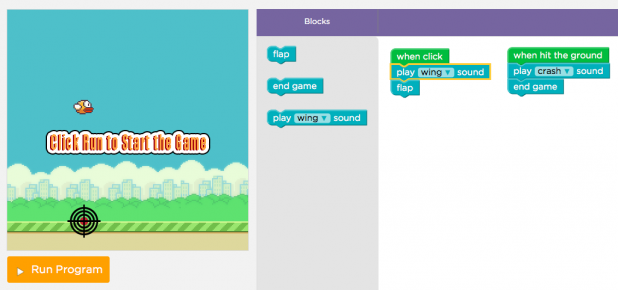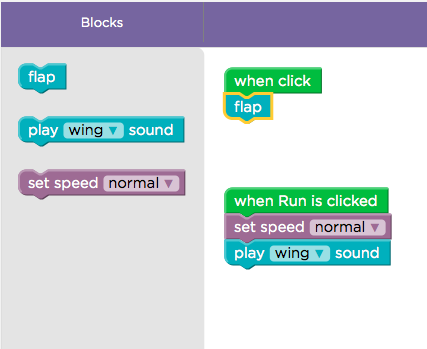
“Flappy Bird” might be kaput, but its hilariously awkward hero is serving another useful purpose in its afterlife: teaching people how to code. “Flappy Bird,” a free mobile game for Android and iOS that asks the player to guide the titular avian through an obstacle course of vertical pipes, became a sensation earlier this year, seizing the top spots on the Apple and Google Play app stores. Its creator, Dong Nguyen, said the game earned him an average of $50,000 a day through in-app advertising—but that didn’t stop him from yanking the game offline in early February. “It is not anything related to legal issues,”
he wrote in a Tweet Feb. 8. “I just cannot keep it anymore.” In the wake of that takedown, gaming and tech pundits wondered aloud whether Nguyen couldn’t deal with the flood of feedback—and trolling—that typically comes with gaming success. Whatever his reasons, though, it’s clear that the developer walked away from a potential fortune.
Now Code.org has resurrected “Flappy Bird,” Phoenix-style, from the smoking wreckage, with a free tutorial that allows anyone with a bit of time to code his or her very own version of the game. There’s no actual code to learn, thanks to a visual interface that allows budding developers to drag “blocks” of commands into place:

“Flappy Bird recently met its untimely death. We might’ve been tempted to cry all day and give up on spreading computer science (not really, but R.I.P Flappy Bird),”
read a note on Code.org’s blog. “Instead, we built a
new drag-and-drop tutorial that lets you build your own Flappy game—whether it’s Flappy Bird, or Flappy Easter Bunny, Flappy Santa, Flappy Shark with Lasers, Flappy Fairy or Flappy Underwater Unicorn.” Code.org recently passed its one-year anniversary, and claims that students have written a billion lines of code as part of the Website’s programming lessons. While it already has an audience, chances are good that, by using one of the most popular mobile games in recent memory as a coding lesson, it could bring in a few more.
Images: code.org
 “Flappy Bird” might be kaput, but its hilariously awkward hero is serving another useful purpose in its afterlife: teaching people how to code. “Flappy Bird,” a free mobile game for Android and iOS that asks the player to guide the titular avian through an obstacle course of vertical pipes, became a sensation earlier this year, seizing the top spots on the Apple and Google Play app stores. Its creator, Dong Nguyen, said the game earned him an average of $50,000 a day through in-app advertising—but that didn’t stop him from yanking the game offline in early February. “It is not anything related to legal issues,” he wrote in a Tweet Feb. 8. “I just cannot keep it anymore.” In the wake of that takedown, gaming and tech pundits wondered aloud whether Nguyen couldn’t deal with the flood of feedback—and trolling—that typically comes with gaming success. Whatever his reasons, though, it’s clear that the developer walked away from a potential fortune. Now Code.org has resurrected “Flappy Bird,” Phoenix-style, from the smoking wreckage, with a free tutorial that allows anyone with a bit of time to code his or her very own version of the game. There’s no actual code to learn, thanks to a visual interface that allows budding developers to drag “blocks” of commands into place:
“Flappy Bird” might be kaput, but its hilariously awkward hero is serving another useful purpose in its afterlife: teaching people how to code. “Flappy Bird,” a free mobile game for Android and iOS that asks the player to guide the titular avian through an obstacle course of vertical pipes, became a sensation earlier this year, seizing the top spots on the Apple and Google Play app stores. Its creator, Dong Nguyen, said the game earned him an average of $50,000 a day through in-app advertising—but that didn’t stop him from yanking the game offline in early February. “It is not anything related to legal issues,” he wrote in a Tweet Feb. 8. “I just cannot keep it anymore.” In the wake of that takedown, gaming and tech pundits wondered aloud whether Nguyen couldn’t deal with the flood of feedback—and trolling—that typically comes with gaming success. Whatever his reasons, though, it’s clear that the developer walked away from a potential fortune. Now Code.org has resurrected “Flappy Bird,” Phoenix-style, from the smoking wreckage, with a free tutorial that allows anyone with a bit of time to code his or her very own version of the game. There’s no actual code to learn, thanks to a visual interface that allows budding developers to drag “blocks” of commands into place:  “Flappy Bird recently met its untimely death. We might’ve been tempted to cry all day and give up on spreading computer science (not really, but R.I.P Flappy Bird),” read a note on Code.org’s blog. “Instead, we built a new drag-and-drop tutorial that lets you build your own Flappy game—whether it’s Flappy Bird, or Flappy Easter Bunny, Flappy Santa, Flappy Shark with Lasers, Flappy Fairy or Flappy Underwater Unicorn.” Code.org recently passed its one-year anniversary, and claims that students have written a billion lines of code as part of the Website’s programming lessons. While it already has an audience, chances are good that, by using one of the most popular mobile games in recent memory as a coding lesson, it could bring in a few more. Images: code.org
“Flappy Bird recently met its untimely death. We might’ve been tempted to cry all day and give up on spreading computer science (not really, but R.I.P Flappy Bird),” read a note on Code.org’s blog. “Instead, we built a new drag-and-drop tutorial that lets you build your own Flappy game—whether it’s Flappy Bird, or Flappy Easter Bunny, Flappy Santa, Flappy Shark with Lasers, Flappy Fairy or Flappy Underwater Unicorn.” Code.org recently passed its one-year anniversary, and claims that students have written a billion lines of code as part of the Website’s programming lessons. While it already has an audience, chances are good that, by using one of the most popular mobile games in recent memory as a coding lesson, it could bring in a few more. Images: code.org 